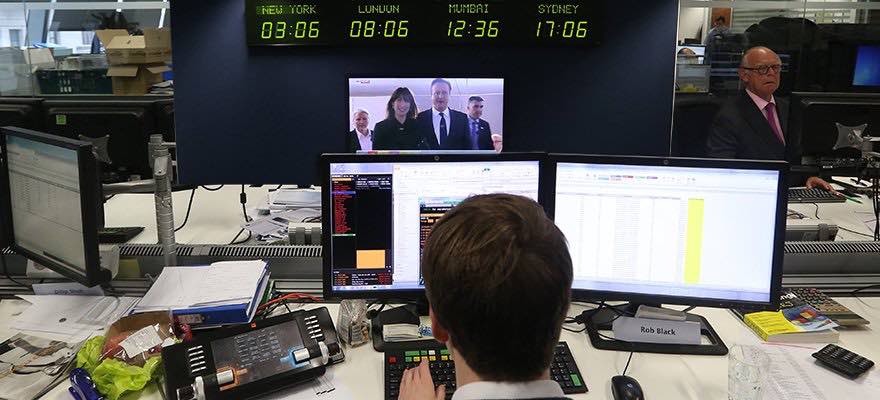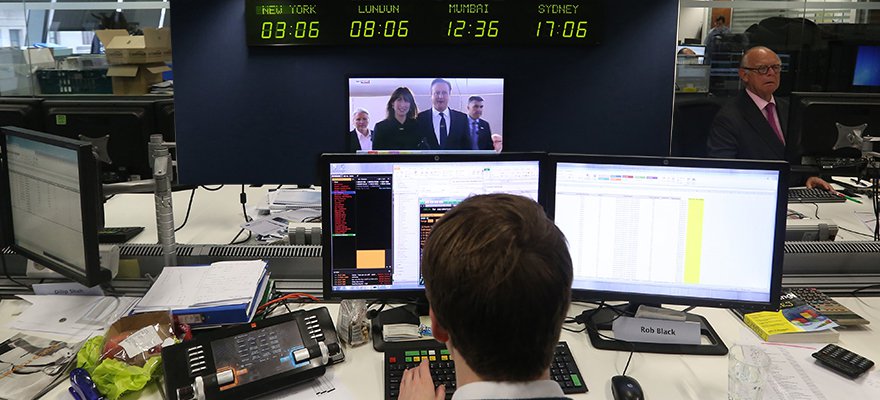This article was written by Evgeniya Rodina, part of the Analytics
Analytics
Analytics may be defined as the detection, analysis, and relay of consequential patterns in data. Analytics also seeks to explain or accurately reflect the relationship between data and effective decision-making. In the trading space, analytics are applied in a predictive manner in an attempt to forecast the price more accurately. This predictive model of analytics generally involves the analysis of historical price patterns that are used in an attempt to determine certain price outcomes. Analy
Analytics may be defined as the detection, analysis, and relay of consequential patterns in data. Analytics also seeks to explain or accurately reflect the relationship between data and effective decision-making. In the trading space, analytics are applied in a predictive manner in an attempt to forecast the price more accurately. This predictive model of analytics generally involves the analysis of historical price patterns that are used in an attempt to determine certain price outcomes. Analy
Read this Term Department at Roboforex
The era of copy trading started approximately three or four years ago. At that time, this instrument for trading on the forex market was discussed ad nauseam, with no shortage of articles, reviews, and opinions about the topic. Presently, the signal providers market has stabilized, although new services and platforms for copying still appear even today given a continued demand for them.
The London Summit 2017 is coming, get involved!
[gptAdvertisement]
As a result, threads relating to such services continue to be popular on traders’ message boards, because most beginners are interested in developing their trading activity using these exact platforms. Advice, which is usually given by veteran traders, is related to trading conditions, execution, commissions, and other aspects of the services offered by signal providers.
User ratings
However, we shouldn’t forget that one of the most essential tools of any of these services is the rating of their users. Usability, completeness of information, and update periods are very crucial for choosing a suitable provider, and the way the rating numbers are formed must provide an objective assessment of providers’ trading activities.
In this review, you’ll learn about key criteria to be used when assessing the rating of signal services, which may probably help you to make a more reasonable choice. The services included in the review have been operating for quite a long time and are the most discussed and mentioned in the trader’s network community, that’s why they are the ones we’re going to talk about. However, your personal choice doesn’t have to be limited to them only. So, let’s take a look.
Parameters usability
The rating of the MQL5 service may be called pretty versatile (at first sight). The general table includes key parameters of the providers, without unnecessary details. Such system allows users to quickly make some kind of tryouts of suitable candidates. The eToro service has the similar structure, but it also has a very important parameter, 'Risk Level', which MQL5 doesn’t.
By extension, the Myfxbook rating (the review will tell about the rating of AutoTrade section) also can be considered pretty simple, but the process of searching and choosing is complicated by poor interface elements (small fonts and charts) and the fact that it’s rather difficult to understand how to go to the rating table from the main page of the website. Unlike other three services, the table of providers offered by ZuluTrade may seem very complicated and include too much information. The button, which allows only key parameters to be displayed in the rating table, is pretty difficult to see with half an eye.
After more detailed manipulations with parameters, the situation changes a bit. Myfxbook has no other filters except for the column sort and that leaves it far behind. MQL5 offers different ways of sorting, a lot of filters, and even search on your broker for safer copying, but the 2‑column rating table makes it difficult to view the trader’s position among the others, and, as a result, the choice once again comes down to viewing and comparing parameters of each of them.
eToro offers a wide range of parameters for choosing best signal providers. All filters that you choose are displayed in the upper panel and thus can be quickly changed or deleted. ZuluTrade implements almost the same system as eToro, but also has some special filters, such as estimations from real users.
The final rankings: ZuluTrade - 8/10, eToro - 8/10, MQL5 - 7/10, Myfxbook - 5/10
Number of positions in the rating and how the trader’s position is defined
ZuluTrade’s rating is not displayed page-by-page, that’s why it’s pretty difficult to see the actual number of providers that are included in the list. On the other hand, after switching to the 'Live Traders' tab (the traders, who trade on real accounts), the number of traders decreases to the point that there isn’t enough information on the page to be loaded additionally.
The rating table is based on the proprietary algorithm, ZuluRank, which sorts the information according to the traders’ 'age', the number of positions that may be open on their account at the same time, and the 'drawdown'. As they say on the service website, this approach helps to assess how successful any given trader is, but won’t do any good in case a subscriber is looking for some specific trading conditions or strategy.
MQL5 offers 2 different rating tables, for MetaTrader4- and MeatTrader5-based accounts respectively. In the first table, you can find 240 pages with signals (20 users on each page), which is quite a lot if taken together. The MT5 accounts table is much shorter and includes only 13 pages with providers. There is little information about the principles and schemes that are used to form the rating table.
One of the instructions states that the rating table is based on several parameters (not a word about which ones), but official statements from MQL5 say that the main criterion is the provider’s “credibility”. However, when looking through the MQL5 rating table, it’s pretty difficult to see any dependence of the provider’s high position in the table on a single parameter.
The eToro rating, provided that all filters in the table are off (not default ones), offers a bit more than 200,000 signal providers, who have been trading in the service over the last two years. The number is impressive, but the more filters we enable, the fewer results we’ll have in the end.
Similar to MQL5, there isn’t much information about how the rating table is formed: the internal calculation formula uses at least 7 different parameters, including the maximum leverage for a single transaction, the minimum investment for a period, and other parameters, which are quite specific. On the one hand, such precision shows the service’s credibility, but on the other hand, it doesn’t really explain how exactly the rating positions are defined.
On the Myfxbook service website, there are several rating tables. The best traders, whose signals may be copied automatically, represent a very small number of all users: they are just 38 people. The total number of systems found in the service is 2,274, although the official FAQ page says it’s more than 90,000.
The highest positions in the rating table are occupied by the systems with the most profitability against the minimum risk in case of stable growth. The formula, which actually takes into account the key trading parameters, doesn’t raise any questions, although it may seem too simplified.
The final rankings: ZuluTrade - 7/10, eToro - 7/10, MQL5 - 7/10, Myfxbook - 6/10
Profitability in the rating table and how real it is
Let’s consider profitability level of traders without using any filters. You should take into account that the formula for calculating profitability varies in different services, that’s why it’s almost impossible to make a direct comparison. Due to different principles and schemes of calculations, the number that shows the maximum profitability is not always (very seldom, in fact) essential.
For instance, the first trader in the list at MQL5 is the one with the profitability (growth) level of 3,300% and 93% of profitable transactions. The runner-up in the table is the trader with the growth level that is four times bigger, but has only 88% of profitable transactions. It’s similar to the situation when the trader with the maximum profitability at Myfxbook (1,600%) and the runner-up have almost the same In-Out, the total number of transactions and transactions closed with profit, but their actual profitability levels differ by a factor of two.
At first sight, the highest percentage of profitability is shown at eToro (more than 20,000%), the lowest – at ZuluTrade (a bit more than 400%). But like we said at the very beginning, this data is not enough to draw a conclusion which service has better and more successful traders and, much less, to help you to choose a signal provider, that’s why these numbers are mentioned only as statistics.
When it comes to reliability of the published data, it is hard to escape the conclusion that investors are very unlikely to make their own calculations about providers’ results in order to check if their statistics is true. In this case, we can only rely on the stability of the results of one or another provider for a long period.
The final rankings: ZuluTrade - 9/10, eToro - 9/10, MQL5 - 9/10, Myfxbook - 9/10
Trading conditions and their transparency
Probably, we should start the final part of our review with eToro, which is actually an officially registered broker. This leads us to the conclusion that all statistics of the client are displayed since they registered at the company and doesn’t include any previous trading activities, thus making them less attractive for the traders, who operate through other platforms.
Nobody knows whether it is really possible to reach the top of the rating (provided that the service has been operating for at least several years) under such circumstances, but that is another story. As for subscriptions to providers, the service charges no additional commissions, and even if it does, it’s kept mum on that subject.
On the other hand, you’ll have to trade with the spread of 3 pips for EUR/USD and 4 pips for GBP/USD, which is 2-3 times more that the average spread on the market. And if you have a lot of transactions, they will cost you a vast deal of money. Taking into account that providers receive 100% of rebates, investors become 'hostages' of this archaic scheme.
In case of other services, it’s a bit different. In order to start trading in any of them, the trader has to connect their account opened at their broker to the service, and if they want to be included into the AutoTrade rating at Myfxbook, they have to have a pretty big equity on their account. According to the cost of use and subscriptions to signals, the services are arranged in the following way:
MQL5 signals are paid by subscribers, the sum to be paid is always specified next to the provider profile (a positive aspect of this approach is that subscribers don’t pay the provider percentage of their profit or any other commissions).
Myfxbook makes no secret that some clients (depending on the broker) may be charged with mark-up, and that other services, which are marketed as “free”, usually hide such commissions. In addition to that, if you want to copy transactions from the best providers, you have to have at least 1,000 USD on your real account.
The subscription commission at ZuluTrade depends on the number of transactions performed by the trader throughout a month and may be up to 350 USD. In addition to that, users are often charged with commissions (sometimes rather significant) for making Payments
Payments
One of the bases of mediums of exchange in the modern world, a payment constitutes the transfer of a legal currency or equivalent from one party in exchange for goods or services to another entity. The payments industry has become a fixture of modern commerce, though the players involved and means of exchange have dramatically shifted over time.In particular, a party making a payment is referred to as a payer, with the payee reflecting the individual or entity receiving the payment. Most commonl
One of the bases of mediums of exchange in the modern world, a payment constitutes the transfer of a legal currency or equivalent from one party in exchange for goods or services to another entity. The payments industry has become a fixture of modern commerce, though the players involved and means of exchange have dramatically shifted over time.In particular, a party making a payment is referred to as a payer, with the payee reflecting the individual or entity receiving the payment. Most commonl
Read this Term. Besides, this information is very difficult to find, so no one knows whether it was done on purpose or the reason lies in a poor way to provide information.
The final rankings: ZuluTrade - 7/10, eToro - 6/10, MQL5 - 9/10, Myfxbook - 8/1
Overall:
- MQL5 – 8.00/10
- ZuluTrade – 7.75/10
- eToro – 7.50/10
- Myfxbook – 7.00/10
At the end of our short and pretty much subjective review, we can say that according to their numbers all services are quite close to each other. However, if we want to be more objective, we should note that ZuluTrade and eToro were let down by the lack of information and transparency about the cost of use, and Myfxbook – by poor presentation and possible inconveniences related to it.
Most MQL5 parameters are at a high level and the only disadvantage, as a matter of fact, may be the way the rating table is displayed on the website. Do you want to make sure how these services’ ratings operate in real life? Check them by yourselves. At least, now you have the information that will help you to look more closely at the things which you don’t usually notice or pay attention to on your own.
This article was written by Evgeniya Rodina, part of the Analytics
Analytics
Analytics may be defined as the detection, analysis, and relay of consequential patterns in data. Analytics also seeks to explain or accurately reflect the relationship between data and effective decision-making. In the trading space, analytics are applied in a predictive manner in an attempt to forecast the price more accurately. This predictive model of analytics generally involves the analysis of historical price patterns that are used in an attempt to determine certain price outcomes. Analy
Analytics may be defined as the detection, analysis, and relay of consequential patterns in data. Analytics also seeks to explain or accurately reflect the relationship between data and effective decision-making. In the trading space, analytics are applied in a predictive manner in an attempt to forecast the price more accurately. This predictive model of analytics generally involves the analysis of historical price patterns that are used in an attempt to determine certain price outcomes. Analy
Read this Term Department at Roboforex
The era of copy trading started approximately three or four years ago. At that time, this instrument for trading on the forex market was discussed ad nauseam, with no shortage of articles, reviews, and opinions about the topic. Presently, the signal providers market has stabilized, although new services and platforms for copying still appear even today given a continued demand for them.
The London Summit 2017 is coming, get involved!
[gptAdvertisement]
As a result, threads relating to such services continue to be popular on traders’ message boards, because most beginners are interested in developing their trading activity using these exact platforms. Advice, which is usually given by veteran traders, is related to trading conditions, execution, commissions, and other aspects of the services offered by signal providers.
User ratings
However, we shouldn’t forget that one of the most essential tools of any of these services is the rating of their users. Usability, completeness of information, and update periods are very crucial for choosing a suitable provider, and the way the rating numbers are formed must provide an objective assessment of providers’ trading activities.
In this review, you’ll learn about key criteria to be used when assessing the rating of signal services, which may probably help you to make a more reasonable choice. The services included in the review have been operating for quite a long time and are the most discussed and mentioned in the trader’s network community, that’s why they are the ones we’re going to talk about. However, your personal choice doesn’t have to be limited to them only. So, let’s take a look.
Parameters usability
The rating of the MQL5 service may be called pretty versatile (at first sight). The general table includes key parameters of the providers, without unnecessary details. Such system allows users to quickly make some kind of tryouts of suitable candidates. The eToro service has the similar structure, but it also has a very important parameter, 'Risk Level', which MQL5 doesn’t.
By extension, the Myfxbook rating (the review will tell about the rating of AutoTrade section) also can be considered pretty simple, but the process of searching and choosing is complicated by poor interface elements (small fonts and charts) and the fact that it’s rather difficult to understand how to go to the rating table from the main page of the website. Unlike other three services, the table of providers offered by ZuluTrade may seem very complicated and include too much information. The button, which allows only key parameters to be displayed in the rating table, is pretty difficult to see with half an eye.
After more detailed manipulations with parameters, the situation changes a bit. Myfxbook has no other filters except for the column sort and that leaves it far behind. MQL5 offers different ways of sorting, a lot of filters, and even search on your broker for safer copying, but the 2‑column rating table makes it difficult to view the trader’s position among the others, and, as a result, the choice once again comes down to viewing and comparing parameters of each of them.
eToro offers a wide range of parameters for choosing best signal providers. All filters that you choose are displayed in the upper panel and thus can be quickly changed or deleted. ZuluTrade implements almost the same system as eToro, but also has some special filters, such as estimations from real users.
The final rankings: ZuluTrade - 8/10, eToro - 8/10, MQL5 - 7/10, Myfxbook - 5/10
Number of positions in the rating and how the trader’s position is defined
ZuluTrade’s rating is not displayed page-by-page, that’s why it’s pretty difficult to see the actual number of providers that are included in the list. On the other hand, after switching to the 'Live Traders' tab (the traders, who trade on real accounts), the number of traders decreases to the point that there isn’t enough information on the page to be loaded additionally.
The rating table is based on the proprietary algorithm, ZuluRank, which sorts the information according to the traders’ 'age', the number of positions that may be open on their account at the same time, and the 'drawdown'. As they say on the service website, this approach helps to assess how successful any given trader is, but won’t do any good in case a subscriber is looking for some specific trading conditions or strategy.
MQL5 offers 2 different rating tables, for MetaTrader4- and MeatTrader5-based accounts respectively. In the first table, you can find 240 pages with signals (20 users on each page), which is quite a lot if taken together. The MT5 accounts table is much shorter and includes only 13 pages with providers. There is little information about the principles and schemes that are used to form the rating table.
One of the instructions states that the rating table is based on several parameters (not a word about which ones), but official statements from MQL5 say that the main criterion is the provider’s “credibility”. However, when looking through the MQL5 rating table, it’s pretty difficult to see any dependence of the provider’s high position in the table on a single parameter.
The eToro rating, provided that all filters in the table are off (not default ones), offers a bit more than 200,000 signal providers, who have been trading in the service over the last two years. The number is impressive, but the more filters we enable, the fewer results we’ll have in the end.
Similar to MQL5, there isn’t much information about how the rating table is formed: the internal calculation formula uses at least 7 different parameters, including the maximum leverage for a single transaction, the minimum investment for a period, and other parameters, which are quite specific. On the one hand, such precision shows the service’s credibility, but on the other hand, it doesn’t really explain how exactly the rating positions are defined.
On the Myfxbook service website, there are several rating tables. The best traders, whose signals may be copied automatically, represent a very small number of all users: they are just 38 people. The total number of systems found in the service is 2,274, although the official FAQ page says it’s more than 90,000.
The highest positions in the rating table are occupied by the systems with the most profitability against the minimum risk in case of stable growth. The formula, which actually takes into account the key trading parameters, doesn’t raise any questions, although it may seem too simplified.
The final rankings: ZuluTrade - 7/10, eToro - 7/10, MQL5 - 7/10, Myfxbook - 6/10
Profitability in the rating table and how real it is
Let’s consider profitability level of traders without using any filters. You should take into account that the formula for calculating profitability varies in different services, that’s why it’s almost impossible to make a direct comparison. Due to different principles and schemes of calculations, the number that shows the maximum profitability is not always (very seldom, in fact) essential.
For instance, the first trader in the list at MQL5 is the one with the profitability (growth) level of 3,300% and 93% of profitable transactions. The runner-up in the table is the trader with the growth level that is four times bigger, but has only 88% of profitable transactions. It’s similar to the situation when the trader with the maximum profitability at Myfxbook (1,600%) and the runner-up have almost the same In-Out, the total number of transactions and transactions closed with profit, but their actual profitability levels differ by a factor of two.
At first sight, the highest percentage of profitability is shown at eToro (more than 20,000%), the lowest – at ZuluTrade (a bit more than 400%). But like we said at the very beginning, this data is not enough to draw a conclusion which service has better and more successful traders and, much less, to help you to choose a signal provider, that’s why these numbers are mentioned only as statistics.
When it comes to reliability of the published data, it is hard to escape the conclusion that investors are very unlikely to make their own calculations about providers’ results in order to check if their statistics is true. In this case, we can only rely on the stability of the results of one or another provider for a long period.
The final rankings: ZuluTrade - 9/10, eToro - 9/10, MQL5 - 9/10, Myfxbook - 9/10
Trading conditions and their transparency
Probably, we should start the final part of our review with eToro, which is actually an officially registered broker. This leads us to the conclusion that all statistics of the client are displayed since they registered at the company and doesn’t include any previous trading activities, thus making them less attractive for the traders, who operate through other platforms.
Nobody knows whether it is really possible to reach the top of the rating (provided that the service has been operating for at least several years) under such circumstances, but that is another story. As for subscriptions to providers, the service charges no additional commissions, and even if it does, it’s kept mum on that subject.
On the other hand, you’ll have to trade with the spread of 3 pips for EUR/USD and 4 pips for GBP/USD, which is 2-3 times more that the average spread on the market. And if you have a lot of transactions, they will cost you a vast deal of money. Taking into account that providers receive 100% of rebates, investors become 'hostages' of this archaic scheme.
In case of other services, it’s a bit different. In order to start trading in any of them, the trader has to connect their account opened at their broker to the service, and if they want to be included into the AutoTrade rating at Myfxbook, they have to have a pretty big equity on their account. According to the cost of use and subscriptions to signals, the services are arranged in the following way:
MQL5 signals are paid by subscribers, the sum to be paid is always specified next to the provider profile (a positive aspect of this approach is that subscribers don’t pay the provider percentage of their profit or any other commissions).
Myfxbook makes no secret that some clients (depending on the broker) may be charged with mark-up, and that other services, which are marketed as “free”, usually hide such commissions. In addition to that, if you want to copy transactions from the best providers, you have to have at least 1,000 USD on your real account.
The subscription commission at ZuluTrade depends on the number of transactions performed by the trader throughout a month and may be up to 350 USD. In addition to that, users are often charged with commissions (sometimes rather significant) for making Payments
Payments
One of the bases of mediums of exchange in the modern world, a payment constitutes the transfer of a legal currency or equivalent from one party in exchange for goods or services to another entity. The payments industry has become a fixture of modern commerce, though the players involved and means of exchange have dramatically shifted over time.In particular, a party making a payment is referred to as a payer, with the payee reflecting the individual or entity receiving the payment. Most commonl
One of the bases of mediums of exchange in the modern world, a payment constitutes the transfer of a legal currency or equivalent from one party in exchange for goods or services to another entity. The payments industry has become a fixture of modern commerce, though the players involved and means of exchange have dramatically shifted over time.In particular, a party making a payment is referred to as a payer, with the payee reflecting the individual or entity receiving the payment. Most commonl
Read this Term. Besides, this information is very difficult to find, so no one knows whether it was done on purpose or the reason lies in a poor way to provide information.
The final rankings: ZuluTrade - 7/10, eToro - 6/10, MQL5 - 9/10, Myfxbook - 8/1
Overall:
- MQL5 – 8.00/10
- ZuluTrade – 7.75/10
- eToro – 7.50/10
- Myfxbook – 7.00/10
At the end of our short and pretty much subjective review, we can say that according to their numbers all services are quite close to each other. However, if we want to be more objective, we should note that ZuluTrade and eToro were let down by the lack of information and transparency about the cost of use, and Myfxbook – by poor presentation and possible inconveniences related to it.
Most MQL5 parameters are at a high level and the only disadvantage, as a matter of fact, may be the way the rating table is displayed on the website. Do you want to make sure how these services’ ratings operate in real life? Check them by yourselves. At least, now you have the information that will help you to look more closely at the things which you don’t usually notice or pay attention to on your own.






















